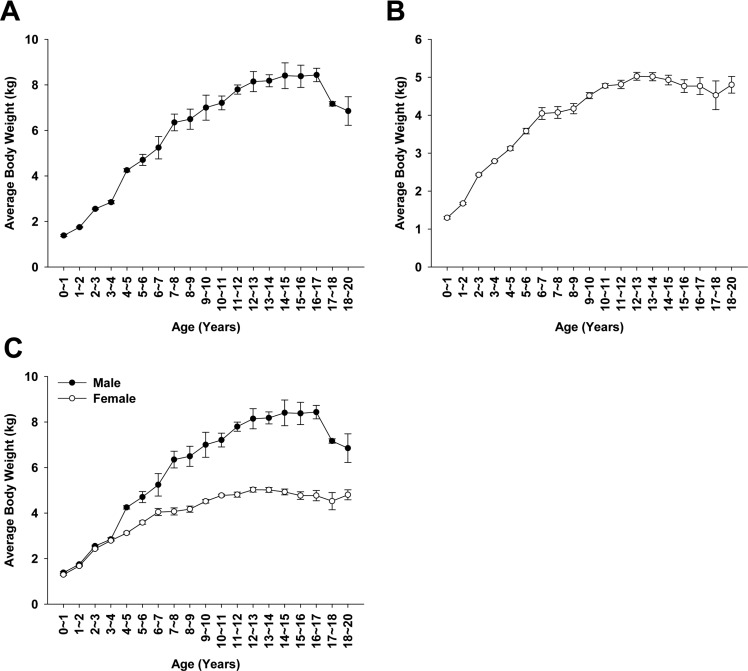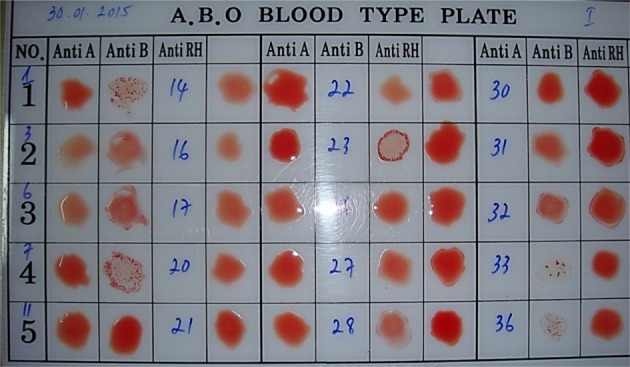Lab Anim Res.
2016 Mar;32(1):46-55. 10.5625/lar.2016.32.1.46.
Reference values of hematology, biochemistry, and blood type in cynomolgus monkeys from cambodia origin
- Affiliations
-
- 1Haeeun Life Science Research Institute, Orient Bio Inc., Sungnam, Korea.
- 2Department of Veterinary Medicine, Kangwon National University, Chuncheon, Korea.
- 3Production, Orient Cam Co., Ltd., Kampong Chhnang, Cambodia.
- 4Haeeun Biomedical Research Institute, Genia Inc., Sungnam, Korea. wanje.park@genia.co.kr
- 5Samsung Biomedical Research Institute, Samsung Medical Center, Seoul, Korea.
- KMID: 2312153
- DOI: http://doi.org/10.5625/lar.2016.32.1.46
Abstract
- Cynomolgus monkeys as nonhuman primates are valuable animal models because they have a high level of human gene homology. There are many reference values for hematology and biochemistry of Cynomolgus monkeys that are needed for proper clinical diagnosis and biomedical research conduct. The body weight information and blood type are also key success factors in allogeneic or xenogeneic models. Moreover, the biological parameters could be different according to the origin of the Cynomolgus monkey. However, there are limited references provided, especially of Cambodia origin. In this study, we measured average body weight of 2,518 Cynomolgus monkeys and analyzed hematology and serum biochemistry using 119 males, and determined blood types in 642 monkeys with Cambodia origin. The average body weight of male Cynomolgus monkeys were 2.56±0.345 kg and female group was 2.43±0.330 kg at the age from 2 to 3 years. The male group showed relatively sharp increased average body weight from the 3 to 4 age period compared to the female group. In hematology and biochemistry, it was found that most of the data was similar when compared to other references even though some results showed differences. The ABO blood type result showed that type A, B, AB, and O was approximately 15.6, 33.3, 44.2, and 6.9%, respectively. The main blood type in this facility was B and AB. These biological background references of Cambodia origin could be used to provide important information to researchers who are using them in their biomedical research.
MeSH Terms
Figure
Reference
-
1. Sibal LR, Samson KJ. Nonhuman primates: a critical role in current disease research. ILAR J. 2001; 42(2):74–84. PMID: 11406709.
Article2. VandeBerg JL, Williams-Blangero S. Advantages and limitations of nonhuman primates as animal models in genetic research on complex diseases. J Med Primatol. 1997; 26(3):113–119. PMID: 9379477.
Article3. Dutrillaux B, Viegas-Péquignot E, Dubos C, Masse R. Complete or almost complete analogy of chromosome banding between the baboon (Papio papio) and man. Hum Genet. 1978; 43(1):37–46. PMID: 97206.
Article4. VandeBerg JL, Williams-Blangero S. Advantages and limitations of nonhuman primates as animal models in genetic research on complex diseases. J Med Primatol. 1997; 26(3):113–119. PMID: 9379477.
Article5. Bonfanti U, Lamparelli D, Colombo P, Bernardi C. Hematology and serum chemistry parameters in juvenile cynomolgus monkeys (Macaca fascicularis) of Mauritius origin: comparison between purpose-bred and captured animals. J Med Primatol. 2009; 38(4):228–235. PMID: 19236562.
Article6. Drevon-Gaillot E, Perron-Lepage MF, Clément C, Burnett R. A review of background findings in cynomolgus monkeys (Macaca fascicularis) from three different geographical origins. Exp Toxicol Pathol. 2006; 58(2-3):77–88. PMID: 16984807.
Article7. Drevon-Gaillot E, Perron-Lepage MF, Clément C, Burnett R. A review of background findings in cynomolgus monkeys (Macaca fascicularis) from three different geographical origins. Exp Toxicol Pathol. 2006; 58(2-3):77–88. PMID: 16984807.
Article8. Kimura N, Tanemura K, Nakamura S, Takashima A, Ono F, Sakakibara I, Ishii Y, Kyuwa S, Yoshikawa Y. Age-related changes of Alzheimer's disease-associated proteins in cynomolgus monkey brains. Biochem Biophys Res Commun. 2003; 310(2):303–311. PMID: 14521910.
Article9. Wu J, Basha MR, Brock B, Cox DP, Cardozo-Pelaez F, McPherson CA, Harry J, Rice DC, Maloney B, Chen D, Lahiri DK, Zawia NH. Alzheimer's disease (AD)-like pathology in aged monkeys after infantile exposure to environmental metal lead (Pb): evidence for a developmental origin and environmental link for AD. J Neurosci. 2008; 28(1):3–9. PMID: 18171917.
Article10. Jayo MJ, Jerome CP, Lees CJ, Rankin SE, Weaver DS. Bone mass in female cynomolgus macaques: a cross-sectional and longitudinal study by age. Calcif Tissue Int. 1994; 54(3):231–236. PMID: 8055372.
Article11. Carlson CS, Loeser RF, Purser CB, Gardin JF, Jerome CP. Osteoarthritis in cynomolgus macaques. III: Effects of age, gender, and subchondral bone thickness on the severity of disease. J Bone Miner Res. 1996; 11(9):1209–1217. PMID: 8864894.
Article12. Wagner JE, Kavanagh K, Ward GM, Auerbach BJ, Harwood HJ Jr, Kaplan JR. Old world nonhuman primate models of type 2 diabetes mellitus. ILAR J. 2006; 47(3):259–271. PMID: 16804200.
Article13. Schuurman HJ, Smith HT. Reference values for clinical chemistry and clinical hematology parameters in cynomolgus monkeys. Xenotransplantation. 2005; 12(1):72–75. PMID: 15598276.
Article14. Bonfanti U, Lamparelli D, Colombo P, Bernardi C. Hematology and serum chemistry parameters in juvenile cynomolgus monkeys (Macaca fascicularis) of Mauritius origin: comparison between purpose-bred and captured animals. J Med Primatol. 2009; 38(4):228–235. PMID: 19236562.
Article15. Schuurman HJ, Smith HT. Reference values for clinical chemistry and clinical hematology parameters in cynomolgus monkeys. Xenotransplantation. 2005; 12(1):72–75. PMID: 15598276.
Article16. Eudey AA. The Crab-Eating Macaque (Macaca fascicularis): Widespread and Rapidly Declining. Primate Conserv. 2008; 23(1):129–132.
Article17. Xie L, Xu F, Liu S, Ji Y, Zhou Q, Wu Q, Gong W, Cheng K, Li J, Li L, Fang L, Zhou L, Xie P. Age- and sex-based hematological and biochemical parameters for Macaca fascicularis. PLoS One. 2013; 8(6):e64892. PMID: 23762263.
Article18. Kanthaswamy S, Ng J, Satkoski Trask J, George DA, Kou AJ, Hoffman LN, Doherty TB, Houghton P, Smith DG. The genetic composition of populations of cynomolgus macaques (Macaca fascicularis) used in biomedical research. J Med Primatol. 2013; 42(3):120–131. PMID: 23480663.
Article19. Kim TM, Park H, Cho K, Kim JS, Park MK, Choi JY, Park JB, Park WJ, Kim SJ. Comparison of Methods for Determining ABO Blood Type in Cynomolgus Macaques (Macaca fascicularis). J Am Assoc Lab Anim Sci. 2015; 54(3):255–260. PMID: 26045449.20. Kim C, Kwon M, Lee H, Han S, Heo J, Ha C, et al. Hematologic and Serum Biochemical Variables in Cynomolgus Monkeys. Korean J Lab Anim Sci. 2004.21. Kawai T, Cosimi AB, Colvin RB, Powelson J, Eason J, Kozlowski T, Sykes M, Monroy R, Tanaka M, Sachs DH. Mixed allogeneic chimerism and renal allograft tolerance in cynomolgus monkeys. Transplantation. 1995; 59(2):256–262. PMID: 7839449.
Article22. Aoyama A, Tonsho M, Ng CY, Lee S, Millington T, Nadazdin O, Wain JC, Cosimi AB, Sachs DH, Smith RN, Colvin RB, Kawai T, Madsen JC, Benichou G, Allan JS. Long-term lung transplantation in nonhuman primates. Am J Transplant. 2015; 15(5):1415–1420. PMID: 25772308.
Article23. Giulietti M, La Torre R, Pace M, Iale E, Patella A, Turillazzi P. Reference blood values of iron metabolism in cynomolgus macaques. Lab Anim Sci. 1991; 41(6):606–608. PMID: 1667207.24. Sugimoto Y, Hanari K, Narita H, Honjo S. Normal hematologic values in the cynomolgus monkeys aged from 1 to 18 years. Jikken Dobutsu. 1986; 35(4):443–447. PMID: 3803429.
Article25. Keiji T. CHAPTER 11 - Management of Old World Primates. In : Sonia WC, editor. The Laboratory Primate. London: Academic Press;2005. p. 163–173.26. Hall RL, Everds NE. Factors affecting the interpretation of canine and nonhuman primate clinical pathology. Toxicol Pathol. 2003; 31(Suppl):6–10. PMID: 12597425.
Article
- Full Text Links
- Actions
-
Cited
- CITED
-
- Close
- Share
- Similar articles
-
- Reference values of hematological and biochemical parameters in young-adult cynomolgus monkey (Macaca fascicularis) and rhesus monkey (Macaca mulatta) anesthetized with ketamine hydrochloride
- Reference values of clinical pathology parameters in cynomolgus monkeys (Macaca fascicularis) used in preclinical studies
- A comparative study on intraocular pressure under various anesthetics in cynomolgus monkeys (Macaca fascicularis)
- Hematological and biochemical reference intervals of wild‑caught and inhouse adult Indian rhesus macaques (Macaca mulatta)
- Surgical removal of a telemetry system in a cynomolgus monkey (Macaca fascicularis): a 12-month observation study



